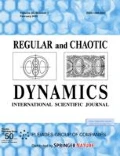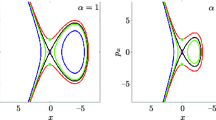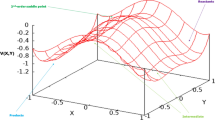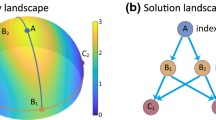Abstract
In this paper we analyze a two-degree-of-freedom Hamiltonian system constructed from two planar Morse potentials. The resulting potential energy surface has two potential wells surrounded by an unbounded flat region containing no critical points. In addition, the model has an index one saddle between the potential wells. We study the dynamical mechanisms underlying transport between the two potential wells, with emphasis on the role of the flat region surrounding the wells. The model allows us to probe many of the features of the “roaming mechanism” whose reaction dynamics are of current interest in the chemistry community.
Similar content being viewed by others
References
Townsend, D., Lahankar, S. A., Lee, S.K., Chambreau, S.D., Suits, A.G., Zhang, X., Rheinecker, J., Harding, L. B., and Bowman, J.M., The Roaming Atom: Straying from the Reaction Path in Formaldehyde Decomposition, Science, 2004, vol. 306, no. 5699, pp. 1158–1161.
Bowman, J.M. and Suits, A.G., Roaming Reactions: The Third Way, Phys. Today, 2011, vol. 64, no. 11, pp. 33–37.
Bowman, J.M. and Shepler, B.C., Roaming Radicals, Annu. Rev. Phys. Chem., 2011, vol. 62, pp. 531–553.
Suits, A.G., Roaming Atoms and Radicals: A New Mechanism in Molecular Dissociation, Acc. Chem. Res., 2008, vol. 41, no. 7, pp. 873–881.
Mauguière, F. A., Collins, P., Kramer, Z. C., Carpenter, B.K., Ezra, G. S., Farantos, S.C., and Wiggins, S., Roaming: A Phase Space Perspective, Annu. Rev. Phys. Chem., 2017, vol. 68, pp. 499–524.
Wiggins, S., Normally Hyperbolic Invariant Manifolds in Dynamical Systems, Appl. Math. Sci., vol. 105, New York: Springer, 2013.
Uzer, T., Jaffé, C., Palacián, J., Yanguas, P., and Wiggins, S., The Geometry of Reaction Dynamics, Nonlinearity, 2002, vol. 15, no. 4, pp. 957–992.
Wiggins, S., Wiesenfeld, L., Jaffé, C., Uzer, T., Impenetrable Barriers in Phase-Space, Phys. Rev. Lett., 2001, vol. 86, no. 24, pp. 5478–5481.
Wiggins, S., The Role of Normally Hyperbolic Invariant Manifolds (NHIMs) in the Context of the Phase Space Setting for Chemical Reaction Dynamics, Regul. Chaotic Dyn., 2016, vol. 21, no. 6, pp. 621–638.
Mauguière, F. A., Collins, P., Kramer, Z. C., Carpenter, B.K., Ezra, G. S., Farantos, S.C., and Wiggins, S., Phase Space Structures Explain Hydrogen Atom Roaming in Formaldehyde Decomposition, J. Phys. Chem. Lett., 2015, vol. 6, no. 20, pp. 4123–4128.
Morse, P. M., Diatomic Molecules According to the Wave Mechanics: 2. Vibrational Levels, Phys. Rev., 1929, vol. 34, no. 1, pp. 57–64.
Borisov, A. V., Mamaev, I. S., and Bizyaev, I. A., The Spatial Problem of 2 Bodies on a Sphere: Reduction and Stochasticity, Regul. Chaotic Dyn., 2016, vol. 21, no. 5, pp. 556–580.
Moser, J., Stable and Random Motions in Dynamical Systems: With Special Emphasis on Celestial Mechanics, Ann. of Math. Stud., No. 77, Princeton, N.J.: Princeton Univ. Press, 2001.
Verlet, L., Computer “Experiments” on Classical Fluids: 1. Thermodynamical Properties of Lennard–Jones Molecules, Phys. Rev., 1967, vol. 159, no. 1, pp. 98–103.
Press, W. H., Teukolsky, S.A., Vetterling, W. T., and Flannery, B.P., Numerical Recipes: The Art of Scientific Computing, 3rd ed., New York: Cambridge Univ. Press, 2007.
Seoane, J.M. and Sanjuán, M.A. F., New Developments in Classical Chaotic Scattering, Rep. Prog. Phys., 2013, vol. 76, no. 1, 016001, 53 pp.
Carpenter, B. K., Nonstatistical Dynamics in Thermal Reactions of Polyatomic Molecules, Annu. Rev. Phys. Chem., 2005, vol. 56, pp. 57–89.
Pechukas, P. and Pollak, E., Classical Transition State Theory Is Exact If the Transition State Is Unique, J. Chem. Phys., 1979, vol. 71, no. 5, pp. 2062–2068.
Pechukas, P. and Pollak, E., Trapped Trajectories at the Boundary of Reactivity Bands in Molecular Collisions, J. Chem. Phys., 1977, vol. 67, no. 12, pp. 5976–5977.
Pollak, E., Child, M. S., and Pechukas, P., Classical Transition State Theory: A Lower Bound to the Reaction Probability, J. Chem. Phys., 1980, vol. 72, no. 3, pp. 1669–1678.
Pollak, E. and Pechukas, P., Transition States, Trapped Trajectories, and Classical Bound States Embedded in the Continuum, J. Chem. Phys., 1978, vol. 69, no. 3, pp. 1218–1226.
Mauguière, F. A., Collins, P., Kramer, Z. C., Carpenter, B.K., Ezra, G. S., Farantos, S.C., and Wiggins, S., Phase Space Barriers and Dividing Surfaces in the Absence of Critical Points of the Potential Energy: Application to Roaming in Ozone, J. Chem. Phys., 2016, vol. 144, no. 5, 054107, 12 pp.
Carpenter, B. K., Ezra, G. S., Farantos, S.C., Kramer, Z.C., and Wiggins, S., Empirical Classification of Trajectory Data: An Opportunity for the Use of Machine Learning in Molecular Dynamics, J. Phys. Chem. B, 12 Oct 2017, DOI: 10.1021/acs.jpcb.7b08707.
Author information
Authors and Affiliations
Corresponding author
Rights and permissions
About this article
Cite this article
Carpenter, B.K., Ezra, G.S., Farantos, S.C. et al. Dynamics on the Double Morse Potential: A Paradigm for Roaming Reactions with no Saddle Points. Regul. Chaot. Dyn. 23, 60–79 (2018). https://doi.org/10.1134/S1560354718010069
Received:
Accepted:
Published:
Issue Date:
DOI: https://doi.org/10.1134/S1560354718010069




